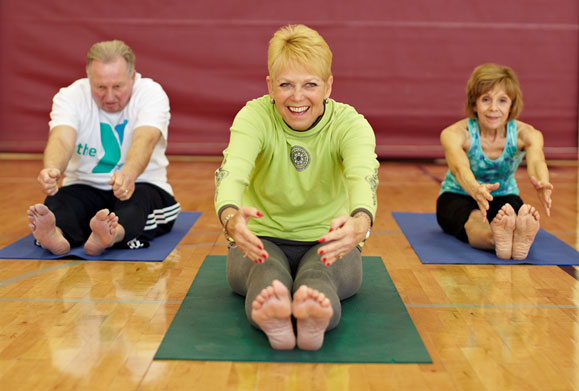Can yoga really be part of your fitness regimen? Yes!

You’ve probably heard about the benefits of yoga—how it reduces stress, calms the nerves, and increases flexibility. Maybe you’ve taken some gentle yoga classes and have experienced this yourself.
Before you attend your first fitness yoga class, here are a few helpful tips from Southdale Y group fitness instructor, Jill Patton.
at the Y are designed to help you develop physical strength, stamina, and coordination, and can definitely complement your other fitness activities. Fitness yoga moves through challenging postures, called asanas, cultivating a greater awareness of the relationship between your body, your mind, and your breath.
I’m not very flexible (or very strong). Will I be able to keep up?
Most fitness yoga classes at the Y are all-levels classes. For many of the asanas, your instructor will offer different variations to accommodate different levels of strength or flexibility.
I have an injury. Can I still participate?
Be sure to let your instructor know about any injuries or chronic conditions you have. Many postures can be modified in some way so that you can get the benefits of the practice without exacerbating an injury. Yoga teachers are not physicians or physical therapists, so if you have a serious or acute condition, it’s wise to consult your doctor before doing this or any other physical activity.
Are all fitness yoga classes the same?
No. Different instructors have different styles, different philosophies, and different personalities. Try several classes to see which one inspires you to come back!
Will there be a lot of chanting or foreign terminology?
Yoga classes at the Y are intended to be accessible and approachable for everyone, so spiritual practices like chanting are not included. If teachers use Sanskrit terms for certain postures, they will also name them in English.
Many teachers and students do close each class by bringing their hands to prayer position at their chest, bowing to each other, and saying “Namaste.” Namaste literally means, “I bow to you,” and is intended to acknowledge the spirit of life within each person.
Do I need my own gear?
The Y provides yoga mats, and props like foam blocks, blankets, and yoga straps. (These can make poses more accessible, or enhance your understanding of a pose.) Many students prefer to purchase their own mats once they’ve caught the yoga bug.
More tips for successful fitness yoga
- If you approach each class with curiosity and a willingness to learn to listen to your body, your practice can follow you throughout your life—becoming stronger and more powerful, or gentler and more nurturing, as you need it.
- Resist the urge to set rigid goals or compete with anyone in the room (including you). Instead, see if you can just experience any challenges that come up without worrying whether you are “good” at yoga or not.
- Different styles of yoga can complement each other. For instance, gentle classes may emphasize subtleties of breath work and posture alignment that many faster-moving fitness yoga classes don’t. Take what you learn in one class and try it out in another.
- Yoga injuries can happen, but these may be avoided if you back away from the mantra of “no pain, no gain.” Instead, pay attention to how your body gradually builds strength, flexibility, and awareness before you move into more advanced postures.